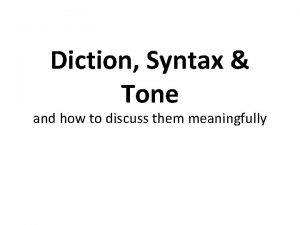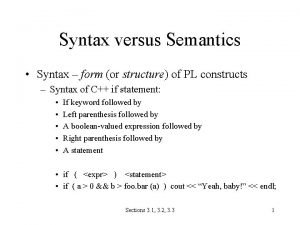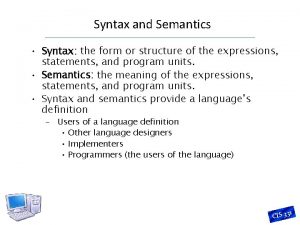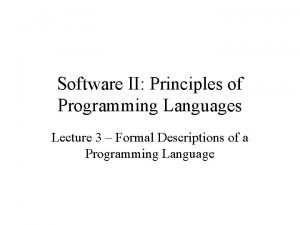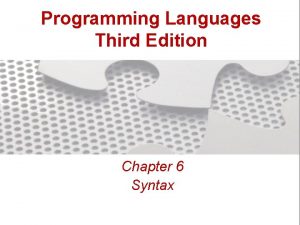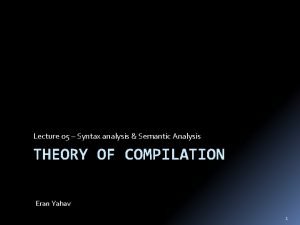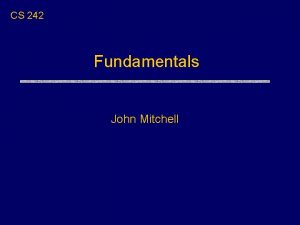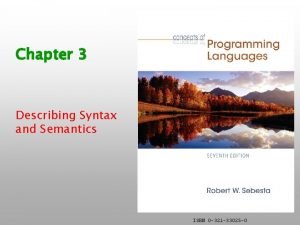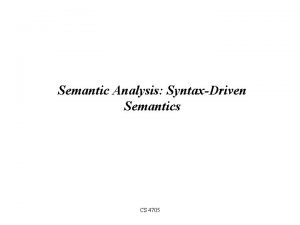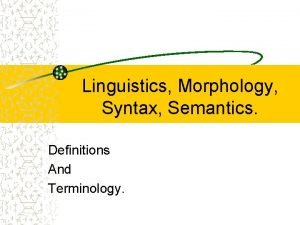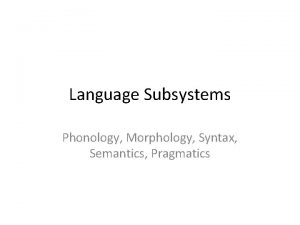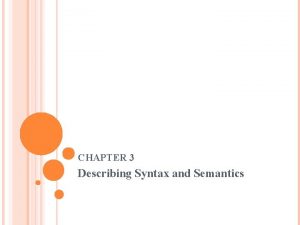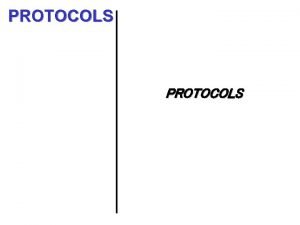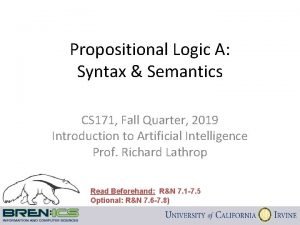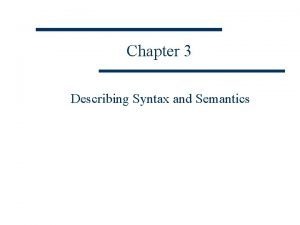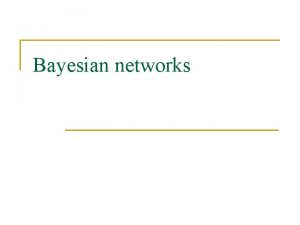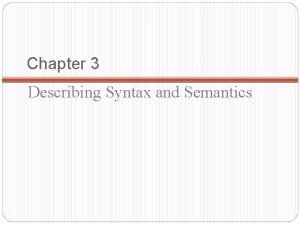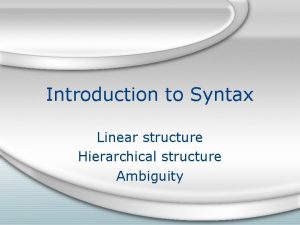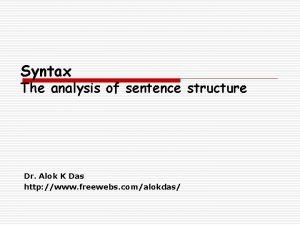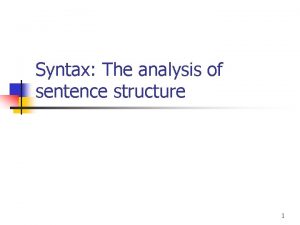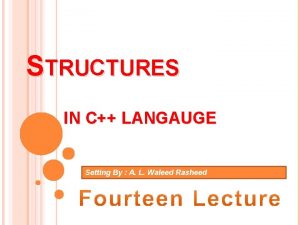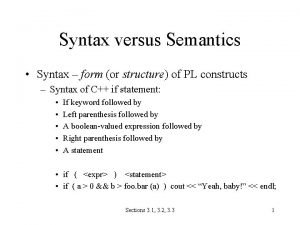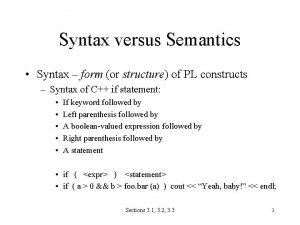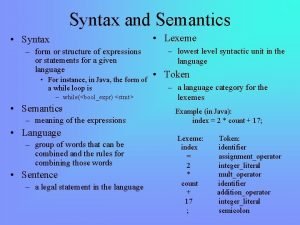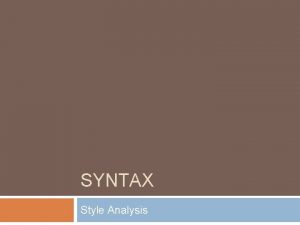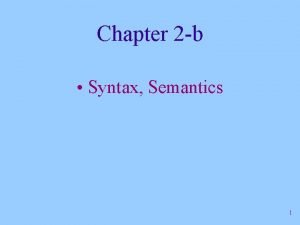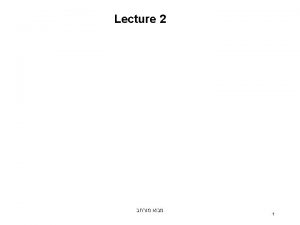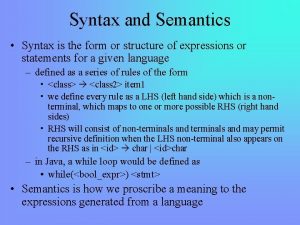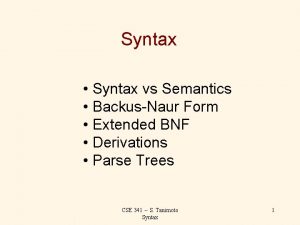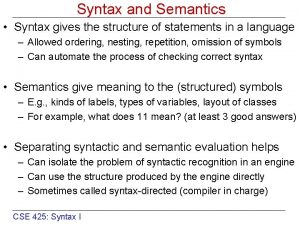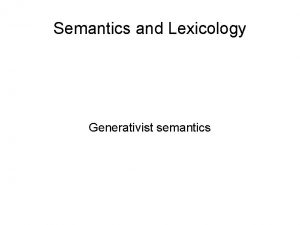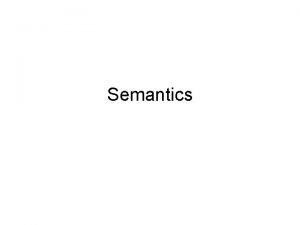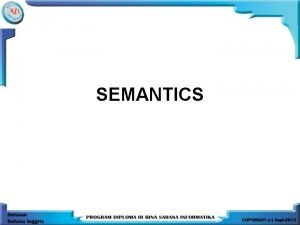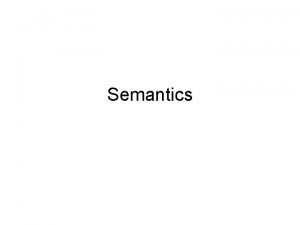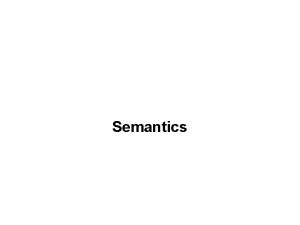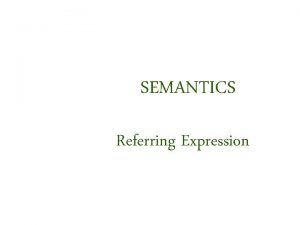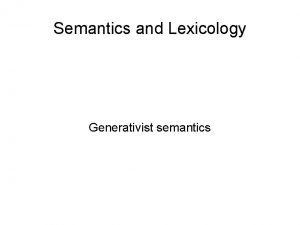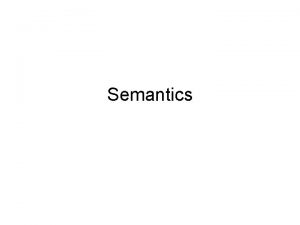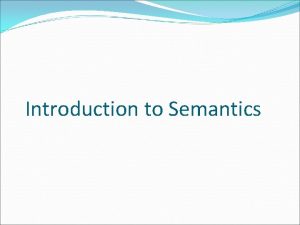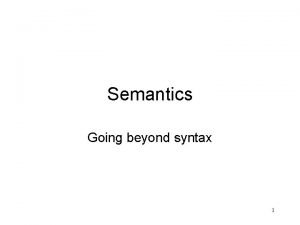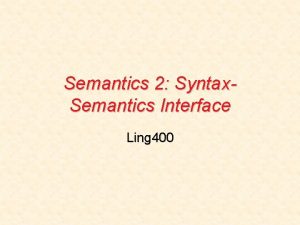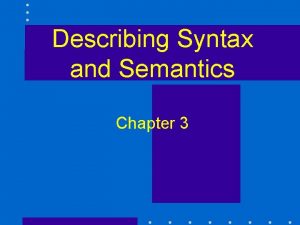Syntax versus Semantics Syntax form or structure of



























- Slides: 27

Syntax versus Semantics • Syntax – form (or structure) of PL constructs – Syntax of C++ if statement: • • • If keyword followed by Left parenthesis followed by A boolean-valued expression followed by Right parenthesis followed by A statement • if ( <expr> ) <statement> • if ( a > 0 && b > foo. bar (a) ) cout << “Yeah, baby!” << endl; Sections 3. 1, 3. 2, 3. 3 1

Syntax versus Semantics • Semantics – meaning of PL constructs – Semantics of C++ if statement: • Evaluate the boolean-valued expression <expr> • If result is true execute statement <statement> • If result is false do not execute statement <statement> Sections 3. 1, 3. 2, 3. 3 2

Describing syntax • Describing syntax is easier than describing semantics • Universally accepted notation available for describing syntax (BNF) • Programming language design goal: semantics should directly follow from syntax (form should suggest meaning) Sections 3. 1, 3. 2, 3. 3 3

Components of a language • Lexemes – smallest units of the language; “words” – Examples: 3, =, ==, +, count, while, if, else • Token – name of a category of lexemes – Identifier: index, count, j, k – Int_constant: 3, 100 – Plusop: + (∞ lexemes in class) (just one lexeme in class) • Sentences (Aka: strings, statements) – Sequence of tokens – An entire “program” is a string/sentence. – Then, is it (the sentence) in the C++ language? Sections 3. 1, 3. 2, 3. 3 4

Formal methods of describing syntax • Backus-Naur Form (BNF) • Context-free Grammar • Extended BNF • Syntax graph Sections 3. 1, 3. 2, 3. 3 5

BNF - Origins • Backus-Naur Form – John Backus and Peter Naur developed a notation (called BNF) for describing programming language syntax • Context-Free Grammar – Noam Chomsky, a linguist, identified four categories of language, one of which is the context free grammar • These two are actually equivalent Sections 3. 1, 3. 2, 3. 3 6

BNF - Definitions • Metalanguage – language used to describe another language • BNF metalanguage contains – Rules (also called productions) • Format: <LHS> → <RHS> – Non-terminals – an abstraction; can be defined by other non-terminals and terminals; <LHS> is always a non-terminal Sections 3. 1, 3. 2, 3. 3 7

BNF - Definitions • Terminals – lexemes and tokens; <RHS> can be a mixture of terminals and nonterminals • Examples (from Pascal) • <ifstmt> → if <logic-expr> then <stmt> else <stmt> or another way to write the two above • <ifstmt> → if <logic-expr> then <stmt> | if <logic-expr> then <stmt> else <stmt> Sections 3. 1, 3. 2, 3. 3 8

BNF - Definitions • Grammar – collection of rules • Recursive rule – LHS appears in the RHS; useful for expressing variable length lists – <ident-list> → identifier | identifier, <ident-list> – This rule is right-recursive because <ident-list> appears at the end (right side) of the rule Sections 3. 1, 3. 2, 3. 3 9

BNF-Definitions • Start symbol – BNF is a generative device – Sentence of the language generated by applying rules – First rule applied is one whose <LHS> is the start symbol <program> → begin <stmt-list> end Sections 3. 1, 3. 2, 3. 3 10

BNF - Definitions • Derivation – a sentence generation, the sentence is derived from the start symbol • Leftmost derivation – derived by replacing the leftmost non-terminal in a sentential form – <program> → begin <stmt_list> end – → begin <stmt>; <stmt_list> end – → begin <var> : = <expression>; <stmt_list> end – … – → begin foo : = 3 + 7; print(foo) end Sections 3. 1, 3. 2, 3. 3 11

BNF - Definitions • Parse tree – hierarchical structure of a sentence; internal nodes are nonterminals; leaf nodes are terminals • Ambiguous grammar – one sentence generated by >= 2 distinct parse trees; (Since compiler generates code program begin stmt_list stmt var from a parse tree, it could generate incorrect code if the grammar was ambiguous!) Sections 3. 1, 3. 2, 3. 3 : = ; end stmt_list expression And so on…. 12

Ambiguous grammar for a simple assignment statement • Rule 1: <assign> → <id> : = <expr> • Rule 2: <id> → A | B | C • Rule 3: <expr> → <expr> + <expr> | <expr> * <expr> | (<exp>) | <id> Sections 3. 1, 3. 2, 3. 3 13

Problems • Show a leftmost derivation for the sentence A : = B + C * A using the grammar on the previous slide • Show that the grammar is ambiguous by drawing two parse trees for the sentence Sections 3. 1, 3. 2, 3. 3 14

Another grammar for simple assignment statements • Rule 1: <assign> → <id> : = <expr> • Rule 2: <id> → A | B | C • Rule 3: <expr> → <id> + <expr> | <id> * <expr> | (<expr>) | <id> Sections 3. 1, 3. 2, 3. 3 15

Problems • Show a derviation for the sentence A : = B + C * A • Show the parse tree for A : = B * C + A • Is the grammar ambiguous • Which operator has higher precedence + or *? Sections 3. 1, 3. 2, 3. 3 16

Precedence • Given a statement with multiple operators, the precedence rules indicate the order in which the operators are to be evaluated. • Can determine the precedence of operators in a statement by drawing the parse tree. • Operators lower in the tree have higher precedence, because they will be “evaluated” earlier. • Note, sometimes operators may have equal precedence and evaluation order is determined by the associativity. Sections 3. 1, 3. 2, 3. 3 17

Another grammar for simple assignment statements • Rule 1: <assign> → <id> : = <expr> • Rule 2: <id> → A | B | C | D • Rule 3: <expr> → <expr> + <term> | <term> • Rule 4: <term> → <term> * <factor> | <factor> • Rule 5: <factor> → (<expr>) | <id> Sections 3. 1, 3. 2, 3. 3 18

Problems • • Show the derivation for A : = B + C * D Show the parse tree Is the grammar ambiguous? Which has higher precedence + or *? Sections 3. 1, 3. 2, 3. 3 19

Designing an unambiguous grammar with desired precedence • Each operand should have its own abstraction – Last example • Abstraction for + was <expr> • Abstraction for * was <term> • Operands with lower precedence should be derived first – Last example: <expr> → <expr> + <term> – <term> → <term> * <factor> – + derived before * Sections 3. 1, 3. 2, 3. 3 20

Associativity • Given operators with equal precedence, the associativity determines whether the operators are evaluated left to right or right to left – Left associative operator - evaluated left to right – Right associative operator – evaluated right to left Sections 3. 1, 3. 2, 3. 3 21

Another grammar for simple assignment statements • Rule 1: <assign> → <id> : = <expr> • Rule 2: <expr> → <id> - <expr> | <id> • Rule 3: <id> → A | B | C Sections 3. 1, 3. 2, 3. 3 22

Problems • Draw a parse tree for A : = A – B – C • Is the grammar ambiguous? • What is the associativity of the subtract operator? Sections 3. 1, 3. 2, 3. 3 23

Yet another grammar (YAG) • Rule 1: <assign> → <id> : = <expr> • Rule 2: <expr> → <expr> - <id> | <id> • Rule 3: <id> → A | B | C Sections 3. 1, 3. 2, 3. 3 24

Problems • Draw a parse tree for A : = A – B – C • Is the grammar ambiguous? • What is the associativity of the subtract operator? Sections 3. 1, 3. 2, 3. 3 25

Designing a grammar with desired associativity • Left recursive rule – yields left associative operator • Right recursive rule – yields right associative operator Sections 3. 1, 3. 2, 3. 3 26

Extended BNF • For wimps: simplifies some of the BNF rules. • 1. An optional part (0 or 1 time) – “metasymbols” are underlined – <ifstm> → if ( <exp> ) <stm> [ else <stm> ] • <ifstm> → if ( <exp> ) <stm> else <stm> • 2. Optional repeat (0 or more times) – <idlist> → <id> { , <id> } • <idlist> → <id> , <idlist> • 3. Multiple-choice (1 from a set; radiobutton) – <expr> → <expr> ( + | - ) <term> • <expr> → <expr> + <term> • <expr> → <expr> - <term> Sections 3. 1, 3. 2, 3. 3 27
 Compare procedural semantics and declarative semantics.
Compare procedural semantics and declarative semantics. Diction/syntax
Diction/syntax Syntax and semantics
Syntax and semantics Syntax vs semantics
Syntax vs semantics Grammar vs syntax vs semantics
Grammar vs syntax vs semantics Syntax vs semantics
Syntax vs semantics Syntax vs semantic
Syntax vs semantic Syntax vs semantics
Syntax vs semantics Syntax vs semantics
Syntax vs semantics Semantics vs syntax
Semantics vs syntax What is syntax and semantics
What is syntax and semantics Phonology syntax semantics pragmatics
Phonology syntax semantics pragmatics General problem of describing syntax and semantics in ppl
General problem of describing syntax and semantics in ppl Syntax semantics and timing
Syntax semantics and timing Syntax and semantics
Syntax and semantics Describing syntax and semantics
Describing syntax and semantics Bayesian networks
Bayesian networks Describing syntax and semantics
Describing syntax and semantics Syntax directed definition and syntax directed translation
Syntax directed definition and syntax directed translation Present continuous negative and interrogative
Present continuous negative and interrogative The hierarchical structure of sentences
The hierarchical structure of sentences Phrase structure rules
Phrase structure rules Det in syntax
Det in syntax C langauge
C langauge Work versus energy
Work versus energy Rods versus cones
Rods versus cones Visie versus missie
Visie versus missie Caste system versus class system
Caste system versus class system

